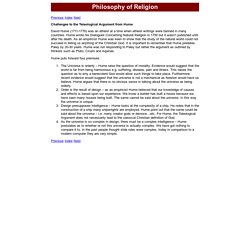

David Hume's Criticisms of Design Arguments - George Teaches. Hi Reader!

This is the second newsletter in my series on arguments for the existence of God. At the end of January, I sent you a video on William Paley's design argument, which focused on his well-known analogy of the watch. This week, I've focused on David Hume's "reply". (I've use inverted commas here, because David Hume died before William Paley published Natural Theology, so his counterargument isn't really a reply.) Anyway, before you hit play, just a heads-up that this video is quite involved: it rattles through the limitations of analogies, the problem of induction, and the specific limitations of design arguments.
Video Player is loading. Current Time 0:00 Duration 11:17 Remaining Time -11:17 Beginning of dialog window. End of dialog window. I hope you found that helpful. Best wishes, George. Evolution and the Catholic Church. The Catholic Church supports theistic evolutionism, although Catholics are free not to believe in any part of evolutionary theory The Catholic Church holds no official position on the theory of creation or evolution, leaving the specifics of either theistic evolution or literal creationism to the individual within certain parameters established by the Church.

According to the Catechism of the Catholic Church, any believer may accept either literal or special creation within the period of an actual six-day, twenty-four-hour period, or they may accept the belief that the earth evolved over time under the guidance of God. Catholicism holds that God initiated and continued the process of his evolutionary creation and that all humans, whether specially created or evolved, have and have always had specially created souls for each individual.[3][4] Catholic schools in the United States and other countries teach evolution as part of their science curriculum.
[edit] Zahm, like St. 9. 1. 159. Fr. Darwin Vs. God: The Clash Between Science & Church? - HistoryExtra. On 12 February 1809, Charles Darwin, the bearded Victorian sage on the ten pound note, was born.

Many people believe he was the man who discovered we come from monkeys. Yet he did no such thing. Writers before Darwin had made connections between humans and apes and monkeys because of our obvious physical similarities. But the theory for which Darwin is so celebrated was not aimed particularly at human ancestry at all.
The implications of Darwin’s theory – most famously espoused in 1859 in the Origin of Species – were so wide-ranging that a concise caricature of what it was all about was probably needed. Instead, Darwin set out to answer the question, how are new species formed? More fantasy than fact We often hear that when the Origin of Species was published there was a great outcry and an historic clash of science and religion. 01 The Teleological Argument. 02 Teleological Argument PPT Notes. 12 RSRev 10 1 Design Argument revision PPT. 01a Teleological Argument Knowledge Organiser.
Teleological Argument Workbook. 02a C3 T1 Inductive Arguments. Anthopic Principle OCR Resources. Modern Design Arguments. Teleological Argument. Strengths And Weaknesses: Teleological Argument. AS Religious Studies Revision: The Teleological Argument AO1 Material: i.e.

‘what goes in part a)?’ 03 challenges and arguments against the teleological argument. 04 Darwin Origin of the Species. Did the dying Stephen Hawking really mean to strengthen the case for God? Scientists have discovered a surprising fact about our universe in the past 40 years: against incredible odds, the numbers in basic physics are exactly as they need to be to accommodate the possibility of life.

If gravity had been slightly weaker, stars would not have exploded into supernovae, a crucial source of many of the heavier elements involved in life. Conversely, if gravity had been slightly stronger, stars would have lived for thousands rather than billions of years, not leaving enough time for biological evolution to take place. 05a Design Argument 1 Crowder. 05b Design Argument 2 Crowder.
The Teleological Argument. Teleological arguments are arguments from the order in the universe to the existence of God.

They are also known as arguments from design (or, to be precise, arguments to design). The name “the teleological argument” is derived from the Greek word telos, meaning “end” or “purpose”. When such arguments speak of the universe being ordered, they mean that it is ordered towards some end or purpose. The suggestion is that it is more plausible to suppose that the universe is so because it was created by an intelligent being in order to accomplish that purpose than it is to suppose that it is this way by chance. 07 Teleological principles. 08 TELEOLOGICAL ARGUMENTS WJEC notes. 09 The Anthropic Principle info sheet. 10 WHO DESIGNED THE DESIGNER. 11 Design Argument revision notes. 13 Teleological notes strengths weaknesses.flipchart.
06 Teleological S&W Sorting. Tutor2u Religious Studies. The Teleological Argument: William Paley. PreviousIndexNext William Paley (1743-1805) wrote a book – Natural Theology or Evidences of the Existence and Attributes of the Deity collected from the Appearances of Nature (1802).

In it he put forward a story to support his teleological argument. Analogy – watch discovered on a heath: Challenges to the Teleological Argument from Hume. PreviousIndexNext David Hume (1711-1776) was an atheist at a time when atheist writings were banned in many countries.

Hume wrote his Dialogues Concerning Natural Religion in 1750 but it wasn’t published until after his death. As an empiricist Hume was keen to show that the study of the natural world could not succeed in telling us anything of the Christian God. It is important to remember that Hume predates Paley by 20-30 years. Hume was not responding to Paley but rather the argument as outlined by thinkers such as Plato, Cicero and Aquinas. Hume puts forward four premises: Challenges to the Teleological Argument from Mill and Darwin. PreviousIndexNext In Nature and Religion (1874) John Stuart Mill (1806-1878) argues that nature is guilty of serious crimes for which she goes unpunished.

The various atrocities through which both humans and animals suffer would not go unpunished if they were the result of Human agency. Design Argument Overview for Revision - World Faiths. The information below is designed to be helpful as a basic overview for students who are covering the Design Argument topic in Edexcel’s AS Philosophy of Religion unit.

AO1 Material: i.e. ‘what goes in part i)?’ Teleological Argument - Philosophical Investigations. God Is the Best Explanation of the Fine-Tuning of the Universe for Intelligent Life. Intelligent Design: Crash Course Philosophy #11. The Design Argument (1 of 2) The Design Argument (2 of 2) Critically evaluate Aquinas’ Fifth Way. [40]
Aquinas’ Fifth Way represents a classic statement of the teleological argument qua purpose. Like Aquinas’ first four ways (Summa Theologica 1, Question 2, Article 3) the argument is inductive and draws the conclusion that God exists a posteriori, following observations of characteristics of the natural world and specifically that all things seem to act for an end (Greek “telos”). Also like Aquinas’ other ways, the fifth way cannot claim to prove God’s existence; as an inductive argument it is limited to concluding that God is the most probable explanation of the aspects of the universe named in the propositions.
Apart from that obvious limitation, Aquinas’ argument is beset by significant problems and, as this essay will demonstrate, fails to achieve its aim of being a good argument for God’s existence. Aquinas’ fifth way can be expressed through the following syllogism P1: natural bodies, which lack intelligence, act for an end. Critically evaluate the classical teleological argument (40) Peped OCR Model Answers Teleological. Paley's Watch paragraph. 04 Effectiveness of the teleological argument. Explain the teleological argument. Critically evaluate the classical teleological argument (40) Vardycharlotte – The RE and Philosophy Echo Chamber.